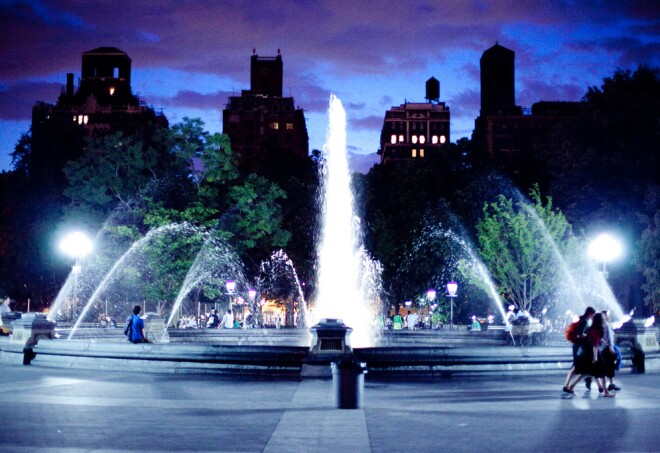New York, NY 10018, USA
A few green acres of valuable Midtown Manhattan real estate affords office workers and visitors with valuable peace and space, two things that are hard to find in the surrounding streets. Bryant Park shares the block between Fifth and Sixth avenues and 41st and 42nd street with the main branch of the New York City Library (also worth a visit). The library runs an al fresco reading room along the north end of the park, and occasionally hosts readings and author events. In summer, a stage at the western edge of the vast green lawn runs a busy schedule of performances and films. In winter, the lawn becomes an ice skating rink and the site of a busy holiday market. All year round, the park is a popular destination for the bocce ball courts, ping pong tables, small carousel, food kiosks, open lawns, gravel paths, seasonal plantings, and a graceful fountain. It may be a challenge to find a seat at lunchtime, but it’s worth the wait. Take a break from your walk and enjoy some great people-watching, as well as shade and a measure of serenity in a green space bound on all sides by tall buildings.
FDR Dr, New York, NY 10009, USA
Work days in the ‘concrete jungle’ are hectic. Long hours are spent indoors, sitting at desks. It’s easy to forget that we live on an island. The East River Walk, beginning at 34th street and the FDR, is where I go to get away from the hustle and bustle. Looking out on the East River, I forget I’m in a city at all. Take a deep breath. Run/walk/bike/skip down to the Brooklyn Bridge and back. If you’re brave, continue around to the West Side.
New York, NY 10012, USA
Washington Square Park is only a fraction of the size of Central Park, but it is as almost as much of an icon of New York as its much larger counterpart uptown. It’s likely because it sits in the heart of Greenwich Village, and has thus served as a backdrop for many events in the city’s history. In the late 19th century, it was one of New York’s most fashionable addresses (that period was captured by Henry James in his 1880 novella Washington Square, later the basis for The Heiress, a play that was also adapted into a movie). The arch along its northern side dates to 1892 and was designed by Stanford White to replace an earlier one, in wood and plaster, erected in 1889 to mark the centennial of George Washington’s inauguration. When Greenwich Village became the haunt of artists and writers, the park was a green space for the city’s counterculture; folk singers and street performers are still a common sight, and the park is also frequently used for political protests and rallies. On sunny days, especially during the academic year, the park is filled with NYU students, neighborhood residents, and tourists taking in the scene.
210 10th Ave, New York, NY 10011, USA
For much of its history, the western edges of Manhattan neighborhoods like the West Village and Chelsea consisted of small manufacturing buildings and warehouses that served the piers on the Hudson River. Over time, those factories were replaced with residential developments, and shipping largely moved out to Brooklyn and New Jersey. What remained, however, was an abandoned light-rail line, located above street level. After 10 years of lobbying the city, state, and federal governments, the first section of the High Line park opened in 2009. It now extends for 1.45 miles, from Gansevoort Street in the south to 34th Street at its other end. An innovative design by James Corner Field Operations uses native species to preserve some of the feeling the old rail line had when it was overgrown with weeds. It has quickly become one of New York’s most popular attractions, both with residents and visitors who stroll the length of it, as well as a model for other cities attempting to find new uses for old infrastructure.
Riverside, Dr To Broadway, New York, NY 10040, USA
Fort Tryon Park is a jewel. Much more off the beaten path for tourists and even locals, the 67-acre park is located in far northern Manhattan on towering cliffs with panoramic views of the Hudson River, the George Washington Bridge, and the New Jersey Palisades. The park’s pedigree features impressive lineage. It was named after the last British governor of colonial New York and was designed by Frederick Law Olmstead, Jr., whose father was the architect of NYC’s beloved Central Park. John D. Rockefeller, Jr. purchased the land in 1917 and gifted it to New York City in 1931. Due to its secluded location, there are far less crowds than other parks. Visitors can luxuriate in quiet corners and tranquility as they stretch their legs. This is the perfect spot for a (hilly) bike ride, run, stroll or walk. Be sure to visit the overflowing Heather Garden and the shaded views from Linden Terrace. The park also has two dog runs, world-famous medieval museum The Cloisters, and upscale eatery New Leaf Restaurant & Bar.
334 Furman St, Brooklyn, NY 11201, USA
Taking a nighttime stroll through Brooklyn, retracing George Washington’s footsteps as he was engaging British forces in Brooklyn and Long Island who went on to invade New York City in the summer of 1776 during the American Revolution (I love a good dose of American history). I paused for a moment to admire the ingenuity and design of the Brooklyn Bridge as well as the Manhattan skyline. Then I found myself humming Alicia Keys’ “Empire State of Mind.”















